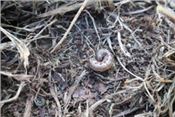Large Numbers Of Fall Armyworms Invading Kentucky Lawns, Crops
LEXINGTON, KEN.
An annual pest is making a big impact this year as high numbers of fall armyworms are causing damage to lawns, crops and pastures across Kentucky.
The fall armyworm is an annual migratory pest that preys on Kentucky crops and pastures to some extent each year. As a result, producers are familiar with scouting for the insect and ways to control them.
However, fall armyworms do not usually invade lawns in the high numbers that University of Kentucky entomologists are receiving reports about this year.
“I’m hearing reports from my colleagues in the South that this could be the worse fall armyworm outbreak since 1977,” said Jonathan Larson, extension entomologist with the UK College of Agriculture, Food and Environment. “We have been receiving calls from local golf courses, homes and lawn centers about turf damage, which is unusual.”
The first sign of fall armyworm damage to a yard is a spot that appears to look drought stressed. That spot will expand, or other spots will appear as the worms move across the lawn. Fall armyworms tend to feed 24/7 and are hidden in the lower zone of the turf.
Homeowners can dump a jug of soapy water on their lawn to get the worms to rise to the surface.
The caterpillars have a distinguishable “Y” shape on the back of their head and three stripes that run down the middle of their bodies.
The integrated pest management traps at Princeton started reporting their first fall armyworm sightings in May of this year.
Fall armyworms will remain active until the first frost of the season.
Larson said the fall armyworms are too far along in their development for organic pest control methods to be effective. If the pest is found in large numbers, homeowners can spray an insecticide that contains either a pyrethroid (like bifenthrin or lambda-cyhalothrin) or carbaryl. Homeowners will have to renovate damaged areas of turf as it is unlikely to bounce back. Some may also choose to do nothing to control the insect and simply renovate their lawns next spring. ∆

A fall armyworm in a Central Kentucky lawn.
Photo by Dan Potter, UK entomologist.